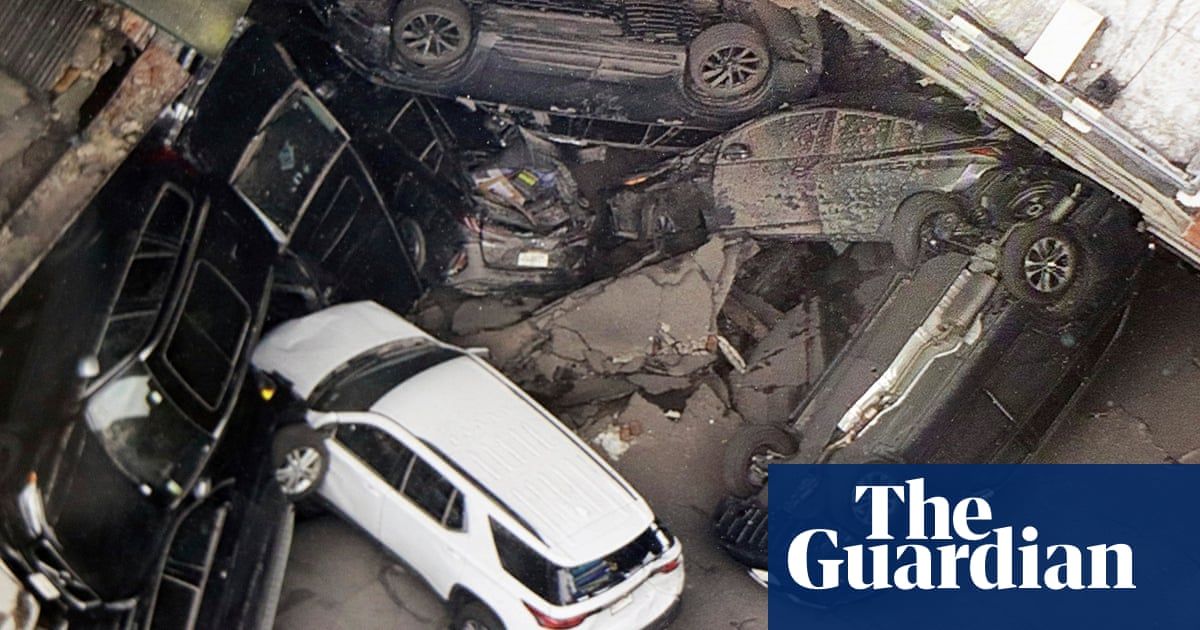‘An inspection could have saved lives’: race to check buildings after New York garage collapse
Last Tuesday, a nearly 100-year-old four-story garage in Manhattan’s financial district caved in, killing the a building manager, Willis Moore, and injuring five others. An employee who survived the disaster told local reporters that he had witnessed long cracks in the garage’s concrete, and that Moore himself had been trying to warn the owners about the issue.
The tragedy was a blaring wakeup call about the condition of New York City’s parking structures. The professional engineers who inspect garages say there may be more of them in need of immediate fixes.
On Tuesday, the city’s department of buildings (DOB) spokesperson announced that following the disaster, it had compiled a list of other garages with open violations related to structural issues. Out of roughly 4,000 parking structures in New York City, the agency identified 61 garages with “immediately hazardous” violations “related to a failure to maintain the building, and which specifically note structural conditions”, a spokesperson said in a statement.
“While we have not received reports that any of these 61 locations are structurally unstable, DOB inspectors are currently sweeping all of these locations out of an abundance of caution, and in the interest of public safety,” the spokesperson added.
The garage that collapsed in Manhattan had multiple open violations that referenced loose or cracked concrete, dating back to 2003. Eric Cowley, a licensed engineer who inspects New York City parking lots, says photos appear to show a girder supporting the top deck fell “like a diving board” – suggesting the structure was already in disrepair – and that the deck appeared to be covered with a porous road surface, which could have added excessive weight and allowed water to seep in. “I think [the cause of the collapse] was that decision-making, and zero maintenance,” Cowley told the Guardian.
Parking is big business in America’s densest city, and regulation has historically been lax. A covered spot in lower Manhattan can easily run $1,000 a month. To maximize profits, many parking lots operate valet-style, so that employees can cram as many vehicles in the building as possible. But until last year, there were no requirements for New York City parking structures to be regularly inspected by engineers.
After the disaster, the city compiled a list of 61 garages with ‘immediately hazardous’ violations. Photograph: Anadolu Agency/Getty Images
The 57 Ann Street building had four open violations with the city’s department of buildings, with one open violation noting “cracks between girders”, “missing concrete covering steel beams” and “defective concrete with exposed rear cracks”. Another open violation from 2009 noted “loose pieces of concrete in danger of falling at various locations”.
Records show the garage owner paid fines for these violations. A DOB spokesperson said the building had carried out repairs in 2010, though it failed to submit required “certificates of correction” to officially close out the violations. The DOB paid two visits to the garage in 2011 and 2013 and “did not find structural concrete conditions at the building which would have necessitated a violation”, the spokesperson said, adding that no DOB inspector had visited the building in the decade since. A representative for Enterprise Ann, the company operating the garage, said that it “continues to cooperate with the agencies involved to investigate the cause of this accident”.
But garages won’t be able to go unmonitored that long any more. A law that went into effect last year requires New York City garage owners to hire a licensed engineer from a list of 50 “qualified parking structure inspectors” to inspect their structures, at least once every six years. The rule is being phased in across the city, with Manhattan garages up first – the doomed Ann Street garage would have been required to do an inspection by the end of this year. But some outer borough garages won’t have to complete an inspection until late 2027.
Now, owners don’t want to wait. Cowley and other qualified garage inspectors say their phones have been ringing off the hook since last week’s collapse. Jason Damiano, an inspector with Rand Engineering and Architecture, said he had “definitely” seen an increase in requests since last Tuesday, including from the owners of faraway garages in Brooklyn and Queens whose inspections weren’t due for years. He worries the small team of inspectors won’t be able to meet the demand: “It’s good to have the work, but whether I can handle it is the issue.”
A covered spot in Manhattan can run to $1,000 a month. Photograph: Ed Jones/AFP/Getty Images
It’s a sharp departure from the usual complacency. Parking spaces are currency, so garages are often reluctant to shut down sections for repairs, Cowley said. “In order to work on one level of a garage, you’d have to take over part of the level below as well. And if you have to work on the ramp, nobody can get in or out.”
The repairs can be costly, so the garages that tend to be more proactive about repairs “are the ones that have the means to do them”, said Rand’s Damiano. He’s seen some garages only take action after pieces of concrete start falling on to customers’ cars: “Eventually you hit a point where car owners are complaining.”
Once inspectors go in, they can find danger quickly. Water dripping from the ceiling is a red flag. The garage’s floor – what engineers call the “traffic membrane” – matters too. Cowley’s firm is repairing a Trump-owned parking garage: “The staff were washing cars on a concrete slab where the original traffic membrane had worn off. So all that water was going into the concrete and coming out downstairs.”
57 Ann isn’t the first New York City garage to collapse. The first floor of a Queens structure buckled in in 1997, forcing the city to halt nearby subway lines to prevent further damage. In 1999, an underground parking garage at a Lower East Side housing complex caved in, crushing cars and leaving a 150ft crater. And in 2010, the facade of a garage on Manhattan’s west side collapsed, raining bricks on to the sidewalk below.
Engineers say part of the tragedy is that it took the city so long to require inspections.
“Certainly, if [57 Ann] had been able to be inspected years ago and was essentially forced to do repairs or to shut down, that could have saved lives,” Damiano said.
“Obviously, these things are mostly catastrophe driven,” Cowley said. “But at least going forward, we’re on top of it. You live and learn, right?”
Source: The Guardian US


